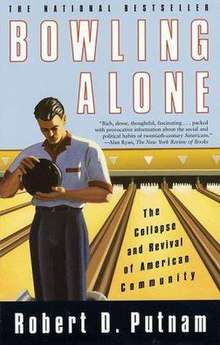Bowling Alone
 | |
| Author | Robert D. Putnam |
|---|---|
| Country | United States |
| Language | English |
| Genre | Nonfiction social science |
Publication date | 2000 |
| Media type | Print (hardback and paperback) |
| ISBN | 0-7432-0304-6 |
Bowling Alone: The Collapse and Revival of American Community is a 2000 nonfiction book by Robert D. Putnam. It was developed from his 1995 essay entitled "Bowling Alone: America's Declining Social Capital". Putnam surveys the decline of social capital in the United States since 1950. He has described the reduction in all the forms of in-person social intercourse upon which Americans used to found, educate, and enrich the fabric of their social lives. He argues that this undermines the active civil engagement, which a strong democracy requires from its citizens.
Contents
Putnam discusses ways in which Americans have disengaged from political involvement including decreased voter turnout, public meeting attendance, serving on committees, and working with political parties. Putnam also cites Americans' growing distrust in their government. Putnam accepts the possibility that this lack of trust could be attributed to "the long litany of political tragedies and scandals since the 1960s",[1] but believes that this explanation is limited when viewing it alongside other "trends in civic engagement of a wider sort".[1]
Putnam notes the aggregate loss in membership and number of volunteers in many existing civic organizations such as religious groups (Knights of Columbus, B'nai Brith, etc.), labor unions, Parent-Teacher Association, Federation of Women's Clubs, League of Women Voters, military veterans' organizations, volunteers with Boy Scouts and the Red Cross, and fraternal organizations (Lions Clubs, Benevolent and Protective Order of Elks, United States Junior Chamber, Freemasonry, Rotary, Kiwanis, etc.).[1] To illustrate why the decline in Americans' membership in social organizations is problematic to democracy, Putnam uses bowling as an example. Although the number of people who bowl has increased in the last 20 years, the number of people who bowl in leagues has decreased. If people bowl alone, they do not participate in social interaction and civic discussions that might occur in a league environment.[1]
Putnam then contrasts the countertrends of ever increasing mass-membership organizations, nonprofit organizations, and support groups to the data of the General Social Survey. This data shows an aggregate decline in membership of traditional civic organizations, supporting his thesis that U.S. social capital has declined. He then asks the obvious question "Why is US social capital eroding?".[1] He does not believe that the "movement of women into the workforce",[1] the "re-potting hypothesis"[1][2] and other demographic changes had much impact on the number of individuals engaging in civic associations. Instead, he suggests the main cause is technology "individualizing" people's leisure time via television and the Internet, suspecting that "virtual reality helmets" will carry this further in future.[1]
Putnam suggests closer studies of which forms of associations can create the greatest social capital, how various aspects of technology, changes in social equality, and public policy affect social capital.[1] He closes by emphasizing the importance of discovering how the United States could reverse the trend of social capital decay.[1]
Reception
A review in Kirkus Reviews praised the book for being understandable for non-academic readers, and said that overall it was an "exhaustive and carefully argued study."[3] The Economist called it "a prodigious achievement."[4] C. S. Fischer, a sociology professor from the University of California, gave a positive review. Although he pointed out a few exaggerations and felt that economic capital was an awkward metaphor, he nevertheless called it "a 10-pin strike, a major contribution to study of social networks and social cohesion" with particular praise for its wide use of data.[5]
Everett Carll Ladd claimed that Putnam completely ignored existing field studies, most notably the landmark sociological Middletown studies,[6] which during the 1920s raised the same concerns he does today, except the technology being attacked as promoting isolation was radio, instead of television and video games.[7]
Other critics questioned Putnam's major finding—that civic participation has been declining. Journalist Nicholas Lemann proposed that rather than declining, civic activity in the US during the 1990s assumed different forms. Instead of bowling leagues, parents integrated themselves into social networks and contribute to the social capital e.g. via youth soccer leagues.[8]
Publication data
- Putnam, Robert D. (2000). Bowling Alone: The Collapse and Revival of American Community. New York: Simon & Schuster. ISBN 0-7432-0304-6.
See also
References
- 1 2 3 4 5 6 7 8 9 10 Putnam, Robert D (1995). "Bowling Alone: America's Declining Social Capital". Journal of Democracy. 6 (1): 65–78. doi:10.1353/jod.1995.0002.
- ↑ Will, George F. (January 5, 1995). "The re-potting hypothesis". The Hour. p. 6.
- ↑ Kirkus Reviews: Bowling Alone
- ↑ "Self-centred". The Economist. 2000-07-06. Retrieved 2018-06-28.
- ↑ Bowling Alone: What's the score?
- ↑ Ladd, Everett Carll (March 1, 1999). "The American way - civic engagement - thrives". Christian Science Monitor.
- ↑ Foley, Michael W; Edwards, Bob (1996). "The Paradox of Civil Society". Journal of Democracy. 7 (3): 38–52. doi:10.1353/jod.1996.0048.
- ↑ Lehmann, Nicholas (April 1996). "Kicking in Groups". The Atlantic.
External links
- Official website
- Lamb, Brian (Dec 24, 2000). "What's the theory of your book?". Interview. Booknotes.
- Galston, W. A. (2001). Hochschild, Jennifer, ed. "Bowling Alone: The Collapse and Revival of American Community". Journal of Policy Analysis and Management. Book reviews. 20 (4): 788. doi:10.1002/pam.1035.